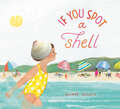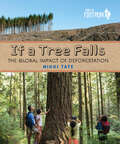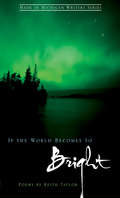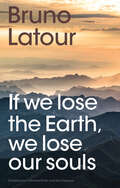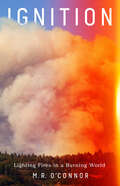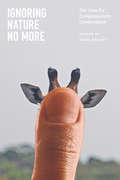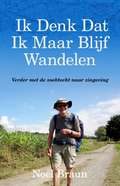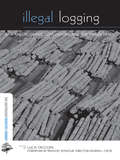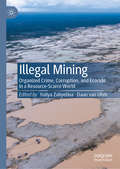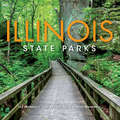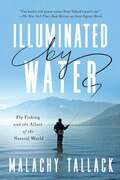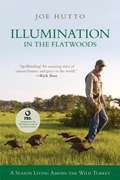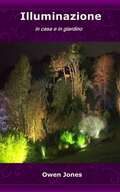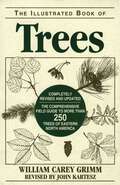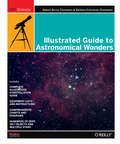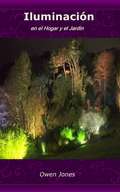- Table View
- List View
If You Spot a Shell (If You Find a Treasure Series)
by Aimée SicuroA stunning companion to If You Find a Leaf, this cheery picture book captures the excitement of summer and encourages children to see their collected seashells in an entirely new way. The artist incorporates real shells into her exquisite illustrations.A warm summer breeze and the gentle waves of the ocean wash ashore many different types of shells. In this story a girl collects shells and thinks of all the magnificent things they can be turned into with a little creativity. She imagines one shell as a swimming cap for diving into the crashing waves, another as a magical kaleidoscope, one as a rocket ship to take her way up high and another as a submarine for exploring the wonders of the world below. The girl draws inspiration from the unique beauty of each and every shell.In this joyous celebration of a day at the beach, artist Aimee Sicuro uses real shells she&’s hand selected to make her oh-so-charming illustrations. Any young reader who turns the pages of this beautiful book will be inspired to use their own imagination as they comb the beach for shells this summer.
If You Want to Visit a Sea Garden
by Kay WeismanDiscover the wonder of ancient sea gardens on the Northwest Coast Sea gardens have been created by First Peoples on the Northwest coast for more than three thousand years. These gardens consist of stone reefs that are constructed at the lowest tide line, encouraging the growth of clams and other marine life on the gently sloped beach. This lyrical story follows a young child and an older family member who set out to visit a sea garden early one morning, as the lowest tides often occur at dawn. After anchoring their boat, they explore the beach, discover the many sea creatures that live there, hear the sputtering of clams and look closely at the reef. They reflect on the people who built the wall long ago, as well as those who have maintained it over the years. After digging for clams, they tidy up the beach, then return home.An author’s note provides further information about sea gardens (also known as clam gardens), which yield a reliable food source and have been traditional places of learning. They have been found along the Pacific coast, from Alaska to British Columbia to Washington State, and some of these gardens are being restored today.The manuscript has been vetted and approved by the scientists of the Clam Garden Network and Kwaxsistalla Wathl’thla Clan Chief Adam Dick. Roy Henry Vickers, whose ancestry includes the Tsimshian, Haida and Heiltsuk First Nations, has created hauntingly beautiful images to accompany the text.Key Text Featuresauthor’s noteCorrelates to the Common Core State Standards in English Language Arts:CCSS.ELA-LITERACY.RI.K.2>With prompting and support, identify the main topic and retell key details of a text.CCSS.ELA-LITERACY.RI.K.6Name the author and illustrator of a text and define the role of each in presenting the ideas or information in a text.
If You're Bored With Acrylics, Read This Book (If You're ... Read This Book Ser.)
by Denise HarrisonUnlock the potential in your paint tubes with 30 guided projects, covering everything from creating a harmonious colour palette to painting vivid landscapes and pop-art portraits. Get back to basics and explore the possibilities of colour, mark-making, textures, tools and techniques, or push the boundaries of acrylics by altering the qualities of the paint. This book will challenge your preconceptions about acrylics, and encourage you to return to the medium with fresh eyes and new ideas.
If You're Bored With Acrylics, Read This Book (If you're ... Read This Book #4)
by Denise HarrisonUnlock the potential in your paint tubes with 30 guided projects, covering everything from creating a harmonious colour palette to painting vivid landscapes and pop-art portraits. Get back to basics and explore the possibilities of colour, mark-making, textures, tools and techniques, or push the boundaries of acrylics by altering the qualities of the paint. This book will challenge your preconceptions about acrylics, and encourage you to return to the medium with fresh eyes and new ideas.
If You're Bored With WATERCOLOUR Read This Book (If you're ... Read This Book #1)
by Veronica Ballart LiljaAre you bored of painting tasteful landscapes, light seascapes and delicate still-lifes? Or are you labouring under the misconception that that is simply all watercolour is good for? Maybe you're so bored of looking at watercolour paintings that you've never even tried it! Whether you're at the beginning of your artistic journey, stuck in a rut and in desperate need of some inspiration or simply looking to improve your skills with watercolour, this book is sure to awaken your creativity. Stimulate your artistic minds and open your paint boxes to a whole new realm of possibility, using things like bleach, salt and combs - yes, the thing you'd ordinarily use to brush your hair with - to create exciting results.Professional fashion illustrator Veronica Ballart Lilja shares a wealth of new techniques based on her years of working with the medium that will open up watercolour for beginners, and encourage experts to stray from their more traditional methods. Jam packed with fresh ideas, adventurous tips and techniques, detailed theory and engaging exercises, this book allows you to develop and practise your skills in a free and expressive way.
If a Tree Falls: The Global Impact of Deforestation (Orca Footprints #18)
by Nikki TateEvery day more of the world’s forests disappear. Trees are cleared for agriculture, lost in wildfires and harvested for the valuable products they supply. Called the lungs of the planet, forests play a critical role in climate moderation. What happens when they’re gone? Are replanting and afforestation efforts helping? In If A Tree Falls: The Global Impact of Deforestation, author Nikki Tate gives an accessible and balanced look at forest practices throughout history, the growth of industry and the fight for preservation. Global deforestation affects us all. Find out what you can do to protect forests today and keep them healthy for future generations.
If the Shoe Fits
by Deborah GuarinoEver wonder what might have happened if a certain glass slipper had been placed on the wrong maiden's foot . . . and fit?! In this comic twist on a classic fairy tale, Murray, a humble shoemaker, presents a pair of glass slippers to the frantic fairy godmother when her wand runs out of power, setting off a rollicking chain of events that may force him to disappoint a prince, risk the fairy’s wrath, and sacrifice the secret love of his life. Deborah Guarino, author of the bestselling Is Your Mama a Llama?, has created a magical story that will delight readers of all ages. Vivid illustrations bring the characters brilliantly to life in this tale of true love, royal mayhem, and big feet.
If the World Becomes So Bright: If The World Becomes So Bright
by Keith TaylorA lyrical and accessible collection that explores both the landscape of Michigan and the inner life of one person who lives there.
If we lose the Earth, we lose our souls
by Bruno LatourIn this book Bruno Latour calls upon Christians to join the struggle to avert a climate catastrophe. First and foremost, Christians need to overcome their lack of interest in “earthly things” and pay attention to the Earth at a time when it is being neglected. He also urges Christians to renew their understanding of their faith in the context of the new image of the world that has emerged from earth system science – that of a world in which the myriad of beings that inhabit the world are interdependent and living in close proximity on a slender, fragile membrane on the surface of the planet. This new image of the world cannot fail to have an impact on the sciences, on politics, and on religion, just as, in earlier centuries, the cosmology of Copernicus and Galileo upset the old order. Latour sees the ecological crisis, and the cosmological mutation that it entails, as an opportunity to convey anew, to the largest possible audience, the tradition of Christianity as it has never been appreciated before, by bringing to bear the lessons of eschatology on the great crisis that looms before us all.
Ignition: Lighting Fires in a Burning World
by M.R. O'ConnorA work of on-the-ground reporting into the science of, and cultural ideas around, wildfires and fire management that challenges the ethos of the conservation movement, offering a hopeful vision of the connection between humans and our environment. In a riveting investigation of the science and ecology of wildfires, journalist M.R. O'Connor ventures into some of the oldest, most beautiful, and remote forests in North America to explore the powerful and ancient relationship between trees, fires, and humans. Along the way, she describes revelatory research in the fields of paleobotany and climate science to show how the world's forests have been shaped by fire for hundreds of millions of years. She also reports on the compelling archeological evidence emerging from the field of ethnoecology that proves how, until very recently, humans were instigators of forest fires, actively molding and influencing the ecosystems around them by inserting themselves into the loop of a natural biological process to start &“good fires.&” As she weaves together first-hand reportage with research and cultural insights, O'Connor also embeds on firelines alongside firefighters and &“pyrotechnicians.&” These highly trained individuals are resurrecting the practice of prescribed burning in an effort to sustain fire-dependent forest ecologies and prevent the catastrophic wildfires that are increasing in frequency and intensity as a result of global warming. Hailing from diverse backgrounds including state and federal agencies, scientific laboratories, and private lands and tribal nations, these fire starters are undertaking a radical and often controversial effort to promote, protect, and expand the responsible use of fire to restore ecological health to landscapes. At the heart of Ignition is a discussion about risk and how our relationship to it as a society will determine our potential to survive the onslaught of climate change.
Ignoring Nature No More: The Case for Compassionate Conservation
by Marc BekoffFor far too long humans have been ignoring nature. As the most dominant, overproducing, overconsuming, big-brained, big-footed, arrogant, and invasive species ever known, we are wrecking the planet at an unprecedented rate. And while science is important to our understanding of the impact we have on our environment, it alone does not hold the answers to the current crisis, nor does it get people to act. In Ignoring Nature No More, Marc Bekoff and a host of renowned contributors argue that we need a new mind-set about nature, one that centers on empathy, compassion, and being proactive. This collection of diverse essays is the first book devoted to compassionate conservation, a growing global movement that translates discussions and concerns about the well-being of individuals, species, populations, and ecosystems into action. Written by leading scholars in a host of disciplines, including biology, psychology, sociology, social work, economics, political science, and philosophy, as well as by locals doing fieldwork in their own countries, the essays combine the most creative aspects of the current science of animal conservation with analyses of important psychological and sociocultural issues that encourage or vex stewardship. The contributors tackle topics including the costs and benefits of conservation, behavioral biology, media coverage of animal welfare, conservation psychology, and scales of conservation from the local to the global. Taken together, the essays make a strong case for why we must replace our habits of domination and exploitation with compassionate conservation if we are to make the world a better place for nonhuman and human animals alike.
Ignoring Nature No More: The Case for Compassionate Conservation
by Marc BekoffFor far too long humans have been ignoring nature. As the most dominant, overproducing, overconsuming, big-brained, big-footed, arrogant, and invasive species ever known, we are wrecking the planet at an unprecedented rate. And while science is important to our understanding of the impact we have on our environment, it alone does not hold the answers to the current crisis, nor does it get people to act. In Ignoring Nature No More, Marc Bekoff and a host of renowned contributors argue that we need a new mind-set about nature, one that centers on empathy, compassion, and being proactive. This collection of diverse essays is the first book devoted to compassionate conservation, a growing global movement that translates discussions and concerns about the well-being of individuals, species, populations, and ecosystems into action. Written by leading scholars in a host of disciplines, including biology, psychology, sociology, social work, economics, political science, and philosophy, as well as by locals doing fieldwork in their own countries, the essays combine the most creative aspects of the current science of animal conservation with analyses of important psychological and sociocultural issues that encourage or vex stewardship. The contributors tackle topics including the costs and benefits of conservation, behavioral biology, media coverage of animal welfare, conservation psychology, and scales of conservation from the local to the global. Taken together, the essays make a strong case for why we must replace our habits of domination and exploitation with compassionate conservation if we are to make the world a better place for nonhuman and human animals alike.
Ik Denk Dat Ik Maar Blijf Wandelen: Verder met de zoektocht naar zingeving
by Noel BraunEen spirituele ontdekkingsreis langs de Camino de Santiago Sinds Maris, zijn geliefde vrouw waarmee hij 42 jaar was getrouwd, zelfmoord pleegde, worstelde Noel Braun om zichzelf terug te vinden. Hij was al zijn levensovertuigingen kwijt, evenals zijn identiteitsgevoel. In een poging opnieuw houvast te vinden, wilde hij een spirituele tocht maken om zichzelf weer te herontdekken. Hij besloot om de populairste routes van de Camino te wandelen, de oude pelgrimsroutes die door Frankrijk en Spanje naar Santiago de Compostela leiden, in het noordwesten van Spanje. Deze tocht staat beschreven in zijn eerdere boek The Day was Made for Walking. Maar de reis was nog lang niet ten einde. Noel voelde de drang om zijn zoektocht verder voort te zetten. Op 80-jarige leeftijd keerde hij terug naar Frankrijk om een wat minder populaire Camino-route te lopen, die hem ook door Frankrijk naar Spanje voerde. Twee jaar later voelde hij opnieuw de dringende behoefte om door te gaan met wandelen, nu vanuit Portugal naar Spanje. Ondanks zijn vergevorderde leeftijd en zijn vele twijfels, heeft hij genoeg vertrouwen en geloof in zichzelf om de zware inspanningen aan te kunnen en Santiago de Compostela te kunnen bereiken. Fascinerende verhalen over de mensen die hij ontmoet zijn vervlochten met zijn spirituele en emotionele tocht. Ik denk dat ik maar blijf wandelen is het vervolg op het eerste boek. Het fysieke komt met het spirituele samen, evenals geschiedenis met het hedendaagse. Het duikt in de geschiedenis en is tegelijkertijd een persoonlijk verslag en een reisgids.
Ill Nature: Rants and Reflections on Humanity and Other Animals
by Joy WilliamsMost of us watch with mild concern the fast disappearing wild spaces or the recurrence of pollution - related crises such as oil spills, toxic blooms in fertilizer-enriched rivers, and the increasing violence in our own country. Joy Williams does much more than watch. With guts and passion, she sounds the alarm over the general disconnection from the natural world that our consumer culture has created. The culling of elephants, electron-probed chimpanzees, and the vanishing wetlands are just some of her subjects. Razor-sharp, controversial, scathingly opinionated, and refreshingly unafraid of conflict, Williams refuses to compromise as she lashes out at the greed of Americans and decries our own turpitude. It is not enough to mourn the passing of the natural world, Ill Nature shouts. Get out of our homes and our cars and our cubicles and do something...now.
Ill Wind: A John Pearce Adventure (John Pearce)
by David DonachieIt is 1793. John Pearce and his Pelicans are going home - to gain their freedom and put the treacherous Captain Ralph Barclay in the dock. Emily Barclay discovers Pearce has papers that would ruin her husband&’s career and her future security. And then comes that dread thing: a fire aboard a wooden ship of war! Cast adrift, Pearce and his Pelicans find help from an unlikely source. Finally, back on British soil, they hope they have reached the end of their troubles, but with the documents missing, the real concerns have only just begun. Emily Barclay holds the key, but where do her loyalties lie?
Illegal Logging: Law Enforcement, Livelihoods and the Timber Trade
by Luca Tacconi'This book carefully blends conceptual insights with extensive empirical evidence to navigate the reader through an issue that is still poorly understood [and is] a valuable reference for the development practitioner to understand the fundamental causes of illegal logging, its myriad consequences and the policy choices available to address the problem' Nalin Kishor, Forest Law Enforcement and Governance Coordinator, The World Bank 'An excellent resource for those working to conserve and sustainably manage forests worldwide. It offers an extensive and comprehensive study of illegal logging, bringing together the knowledge and views of experts who examine its roots and social, economic and environmental implications. One of its important contributions is to show that, unless coupled with reform of forestry regulations to take into account local people, law enforcement to curb illegal logging can negatively impact them. Therefore, any effective and fair approach to the problem needs to involve governments, forestry operators and local communities alike' Gonzalo Oviedo, Senior Social Policy Advisor, IUCN In many countries illegal logging now accounts for a large share of the harvest. Once cut, illegal logs feed an insatiable demand for exotic hardwoods in developed and developing countries. The result has been loss of both revenue and biodiversity, and consequently the issue has risen to the top of the global forest policy agenda as one of the major threats to forests, and donors and national governments are starting to develop initiatives to control illegal logging. Yet for such a massive illegal trade, there is surprisingly limited knowledge available as to the major causes of illegal logging and its impacts on biodiversity, people and livelihoods and national economies, and thus plenty of speculation and action without evidence. It is clear that while illegal logging does have negative impacts, it also, controversially, and perhaps paradoxically, benefits many stakeholders, including local communities. This book, written by the world's foremost experts, examines the key issues including law and enforcement, supply and demand, corruption, forest certification, poverty, local livelihoods, international trade and biodiversity conservation. It includes key case studies from forest-rich hotspots in North, South and Central America, equatorial Africa and Indonesia. While there are clearly no easy answers, this book sorts fact from fiction and explores the many dimensions of the causes, impacts and implications for forests, people, livelihoods and forest policy. Published with CIFOR
Illegal Mining: Organized Crime, Corruption, and Ecocide in a Resource-Scarce World
by Daan Van Uhm Yuliya ZabyelinaThis book provides a comprehensive analysis of the illegal extraction of metals and minerals from the perspectives of organized crime theory, green criminology, anti-corruption studies, and victimology. It includes contributions that focus on organized crime-related offences, such as drug trafficking and trafficking in persons, extortion, corruption and money laundering and sheds light on the serious environmental harms caused by illegal mining. Based on a wide range of case studies from the Amazon rainforest through the Ukrainian flatlands to the desert-like savanna of Central African Republic and Australia’s elevated plateaus, this book offers a unique insight into the illegal mining business and the complex relationship between organized crime, corruption, and ecocide. This is the first book-length publication on illegal extraction, trafficking in mined commodities, and ecocide associated with mining. It will appeal to scholars working on organized crime and green crime, including criminologists, sociologists, anthropologists, and legal scholars. Practitioners and the general public may welcome this comprehensive and timely publication to contemplate on resource-scarcity, security, and crime in a rapidly changing world.
Illinois State Parks
by Lee Mandrell DeeDee Niederhouse-MandrellDiscover the breathtaking beauty and unforgettable adventures that await in Illinois state parks. Lee Mandrell and DeeDee Niederhouse-Mandrell highlight the incredible diversity and natural beauty of the landscapes, flora, and fauna of the state. Marvel at the unique rock formations and 55 foot opening at Cave-In-Rock State Park, or leave the land behind to explore the waterways at Chain O’ Lakes State Park. Step into history at Fort Massac State Park, or sit back and enjoy a striking sunset over the cypress grove at Eldon Hazlet State Park, Illinois’ largest campground. Just in time for the state bicentennial, Illinois State Parks brings together more than 130 gorgeous full-color photographs highlighting some of the most beautiful and popular state parks in Illinois.
Illuminated by Water: Fly Fishing and the Allure of the Natural World
by Malachy TallackIn its blending of nature writing and memoir—also touching on the connection of time, beauty, and memory—Illuminated by Water is an elegiac tribute to fly fishing and the natural world.Illuminated by Water is a book about the author&’s own decades-long passion for fly fishing and how it has shaped the way he sees and thinks about the natural world. That passion is shared and made legible here, not just for other anglers, but for those who have never yet cast a line in the water. Why is it that catching fish—or even thinking about catching fish—can be so thrilling, so captivating? Why is it that time spent beside water can be imprinted so sharply in the memory? Why is it that what seems a simple act of casting a line and hoping can feel so rich in mystery? Alternating between regional and thematic chapters, Tallack considers &‘wildness&’, its pursuit, and its meanings; the compulsive appeal of tying flies; the ethics of catching and killing; the allure of big fish; and beauty—where it&’s sought and where it&’s found. He describes fly fishing trips to America, Canada, Shetland, and England. Throughout the book, certain themes recur—environmental harm and healing; the relationship between fishing and time; hope and its manifestations; and the ways in which angling can deepen engagement with the natural world.
Illumination in the Flatwoods: A Season With the Wild Turkey
by Joe HuttoThe acclaimed account of an astonishing human-turkey relationship. The author describes how he hatched two clutches of wild turkey eggs in an incubator and raised the poults to maturity. Imprinting on him from the moment they hatched, the turkeys fully accepted their human parent into their world. Hutto records their explorations together through fields and woods and the development of their communication and mutual awareness. Along the way he reflects upon the nature of consciousness and the place of humans and animals in the environment.
Illuminazione: in casa e in giardino (Come fare per... #64)
by Owen JonesIlluminazione in casa e in giardino Spero che troverai le informazioni utili, funzionali e redditizie. Le informazioni contenute in questo ebook, su vari aspetti dell'illuminazione domestica per la decorazione e la sicurezza, sono organizzate in 15 capitoli di circa 500-600 parole ciascuno. Spero che susciterà l’interesse di chi desidera aumentare la bellezza e la sicurezza della propria casa. Come bonus aggiuntivo, ti autorizzo a utilizzare il contenuto sul tuo sito web o nei tuoi blog e nelle tue newsletter, anche se è meglio che lo rielabori prima con parole tue. Puoi anche dividere il libro e rivendere gli articoli. In sostanza, l'unico diritto che non hai è quello di rivendere o regalare il libro così come ti è stato consegnato.
Illustrated Book of Trees
by William Carey GrimmCompletely revised and updated. More than 30 new species described and illustrated.
Illustrated Guide to Astronomical Wonders: From Novice to Master Observer
by Robert Bruce Thompson Barbara Fritchman ThompsonWith the advent of inexpensive, high-power telescopes priced at under $250, amateur astronomy is now within the reach of anyone, and this is the ideal book to get you started. The Illustrated Guide to Astronomical Wonders offers you a guide to the equipment you need, and shows you how and where to find hundreds of spectacular objects in the deep sky -- double and multiple stars as well as spectacular star clusters, nebulae, and galaxies.You get a solid grounding in the fundamental concepts and terminology of astronomy, and specific advice about choosing, buying, using, and maintaining the equipment required for observing. The Illustrated Guide to Astronomical Wonders is designed to be used in the field under the special red-colored lighting used by astronomers, and includes recommended observing targets for beginners and intermediate observers alike. You get detailed start charts and specific information about the best celestial objects.The objects in this book were chosen to help you meet the requirements for several lists of objects compiled by The Astronomical League.Binocular Messier ClubUrban Observing ClubDeep Sky Binocular ClubDouble Star ClubRASC Finest NGC ListCompleting the list for a particular observing club entitles anyone who is a member of the Astronomical League or RASC to an award, which includes a certificate and, in some cases, a lapel pin.This book is perfect for amateur astronomers, students, teachers, or anyone who is ready to dive into this rewarding hobby. Who knows? You might even find a new object, like amateur astronomer Jay McNeil. On a clear cold night in January 2004, he spotted a previously undiscovered celestial object near Orion, now called McNeil's Nebula. Discover what awaits you in the night sky with the Illustrated Guide to Astronomical Wonders.
Illustrated Guide to Trees and Shrubs: A Handbook of the Woody Plants of the Northeastern United States and Adjacent Canada/Revised Edition
by Arthur Harmount GravesAuthoritative, easily accessible guide omits lengthy technical descriptions in favor of easy-to-use keys covering such characteristics as leaves, twigs, bark, buds, seeds, stems, fruit or fruit stalks, and other identifying traits. Over 300 pen-and-ink drawings by Maud H. Purdy, noted botanical illustrator. "I recommend this book most highly." -- Farida A. Wiley, American Museum of Natural History.
Iluminación en el Hogar y el Jardín (Como hacer... #64)
by Owen JonesIluminación en el hogar y el jardín por Owen Jones Ideas para iluminar el hogar y el jardín Una introducción al uso de la luz para proteger y exhibir de la manera más efectiva su hogar y jardín Iluminación en el hogar y el jardín Espero que la información les resulte útil, interesante y rentable. La información de este libro electrónico sobre diversos aspectos de la iluminación doméstica para la decoración y la seguridad está organizada en 15 capítulos de aproximadamente 500 a 600 palabras cada uno. Espero que sea de útil para aquellos que estén interesados en utilizar este medio económico para aumentar la belleza y la seguridad de su hogar. Como un bono adicional, le concedo permiso para usar el contenido en su propia página web o en sus propios blogs y boletines de noticias, aunque es mejor que los reescriba con sus propias palabras primero. También puede dividir el libro y revender los artículos. De hecho, el único derecho que no tiene es revender o regalar el libro tal como se le entregó.
